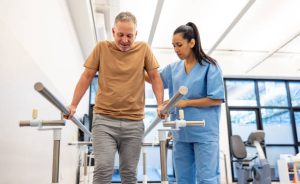When you think of physical therapy, chances are you imagine exercises, machines, maybe some stretching. But at the heart of many successful therapy sessions is something simple, yet profoundly powerful: touch. The hands-on connection between therapist and patient isn’t just comforting—it’s rooted in science and plays a crucial role in healing and recovery.
At Allegiance Physical Therapy, we understand that touch is more than just a technique—it’s a bridge that connects expertise with your body’s natural ability to heal. But why exactly does physical contact matter so much in therapy? Let’s dive into the fascinating science behind touch and discover why it’s a cornerstone of effective treatment.
Touch Triggers Healing at a Cellular Level
Our bodies are incredibly responsive to touch. When a skilled therapist applies manual therapy—like gentle massage, joint mobilization, or myofascial release—it’s not just your muscles and joints responding. The cells beneath your skin react, too.
Touch stimulates the release of biochemical messengers like endorphins, which are natural painkillers. It also encourages the production of oxytocin, often called the “bonding hormone,” which helps reduce stress and promote feelings of calm. This cocktail of chemicals speeds up your body’s natural healing process, reduces pain, and lowers inflammation.
Touch Activates Your Nervous System
When your therapist’s hands make contact, sensory receptors in your skin send signals to your brain. This communication can alter how your nervous system processes pain. In fact, gentle, targeted touch can “reset” nerve pathways, dampening pain signals and promoting relaxation.
This effect is why manual therapy can provide immediate relief, even after just one session. Your brain interprets the soothing touch as a safe, calming signal, which helps relax tight muscles and decrease the sensation of pain.
Physical Contact Helps Break the Pain Cycle
Chronic pain often creates a vicious cycle: pain causes muscle tightness, tightness leads to more pain, and the cycle continues. Touch interrupts this loop. By relaxing muscles and mobilizing joints, physical contact eases tension and improves circulation, allowing tissues to heal more efficiently.
When your body feels safe and supported through touch, it becomes less guarded. This openness lets your therapist guide you through movement and rehabilitation exercises more effectively, speeding up your recovery.
The Emotional Power of Touch in Therapy
Healing isn’t just physical—it’s emotional, too. Pain and injury can bring feelings of fear, frustration, and isolation. Physical contact helps bridge that gap by creating a sense of connection and trust.
Studies show that touch reduces stress hormones like cortisol and promotes emotional well-being. When you feel cared for and understood through the simple act of touch, your motivation to engage in therapy and follow through with exercises increases. That emotional boost can be just as important as the physical benefits.
Personalized Care Through Touch
Every body is unique, and so is every injury. The beauty of manual therapy is how adaptive it is. A skilled therapist reads subtle feedback through touch—the way your muscles respond, where you hold tension, and how your joints move. This hands-on approach allows them to tailor treatments in real time, making therapy more precise and effective.
Final Thoughts
Touch is more than just a comforting gesture—it’s a scientifically proven tool that accelerates healing, reduces pain, and nurtures emotional well-being. At Allegiance Physical Therapy, our hands-on approach combines expert knowledge with the healing power of touch to help you recover faster and feel better.
So next time you come in for a session, remember: that physical connection is working in harmony with your body and mind, guiding you toward a healthier, pain-free life.







